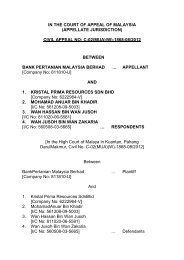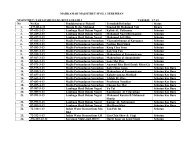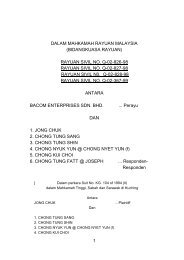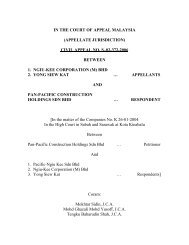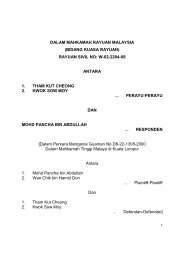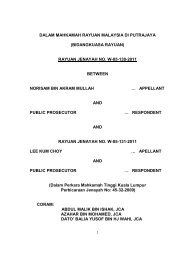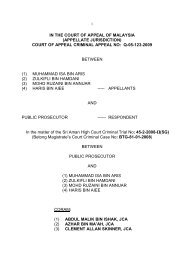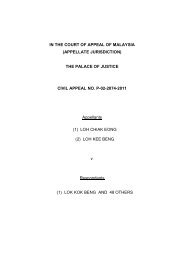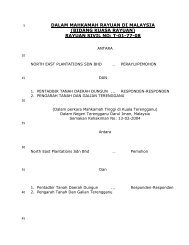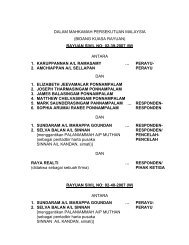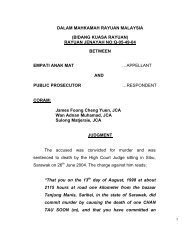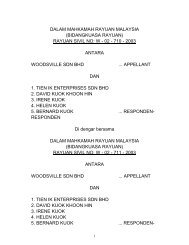rayuan jenayah no. b-05-18-2009 antara faisal bin abd. aziz
rayuan jenayah no. b-05-18-2009 antara faisal bin abd. aziz
rayuan jenayah no. b-05-18-2009 antara faisal bin abd. aziz
Create successful ePaper yourself
Turn your PDF publications into a flip-book with our unique Google optimized e-Paper software.
DALAM MAHKAMAH RAYUAN MALAYSIA<br />
(BIDANG KUASA RAYUAN)<br />
RAYUAN JENAYAH NO. B-<strong>05</strong>-<strong>18</strong>-<strong>2009</strong><br />
ANTARA<br />
FAISAL BIN ABD. AZIZ … PERAYU<br />
DAN<br />
PENDAKWA RAYA … RESPONDEN<br />
(Dalam Mahkamah Tinggi Di Shah Alam<br />
CORAM:<br />
HASAN LAH, JCA<br />
ABDUL MALIK BIN ISHAK, JCA<br />
MOHAMED APANDI BIN ALI, JCA<br />
Perbicaraan Jenayah No. 45-83-2006<br />
Antara<br />
Faisal <strong>bin</strong> Abd. Aziz<br />
Dan<br />
Pendakwa Raya)<br />
1
GROUNDS OF JUDGMENT<br />
The Appellant has been convicted for an offence under<br />
Section 39B(1)(a) of the Dangerous Drugs Act 1952 and<br />
sentenced to death under Section 39B(2) of the Act. The charge<br />
against the Appellant reads as follows:-<br />
“Bahawa kamu pada 23 Januari 2006, jam lebih kurang 5.30<br />
petang, di kawasan kelapa sawit Cyberjaya Dengkel, di dalam<br />
Daerah Sepang di dalam Negeri Selangor Darul Ehsan, telah<br />
memperedarkan dadah berbahaya jenis Cannabis seberat 406.93<br />
gram, oleh yang demikian kamu telah melakukan suatu kesalahan<br />
di bawah Seksyen 39B(1)(a) Akta Dadah Berbahaya 1952 dan<br />
boleh dihukum di bawah Seksyen 39B(2) Akta yang sama.”.<br />
Factual Background<br />
As per the opening speech by the prosecution, the case for the<br />
prosecution commenced with the usage of an agent provocateur in<br />
the form of a police personnel, L/Cpl. Mohd. Hafiz <strong>bin</strong> Zainuddin<br />
(SP2). The facts of the case can be briefly narrated as follows:-<br />
(a) On 23 rd January 2006 at about 1 pm, SP2, L/Cpl. Mohd.<br />
Hafiz acting on information received and upon receiving a<br />
contact number from a source, contacted the Appellant<br />
via his hand-phone. SP2 contacted the Appellant via the<br />
said given number, which was 019-6324234.<br />
Masquerading as a potential buyer, SP2 enquired to<br />
purchase Cannabis worth RM100.00. The man at the<br />
2
end of the line responded positively and an arrangement<br />
was made for the purchase to be done later in the late<br />
after<strong>no</strong>on on the same day, i.e. on 23 rd January 2006.<br />
(b) SP2 then informed his superior, Insp. Syed Nadzely <strong>bin</strong><br />
Syed Jaafar (SP3) of the arrangement for the purchase of<br />
the drugs. SP3 then mobilized an ambush party<br />
comprising SP2 and seven other police personnels. At<br />
5.<strong>05</strong> pm SP2 made a second call to the hand-phone<br />
number 019-6324234 and the person who answered the<br />
call sounded like the one who responded to the earlier<br />
call. The person informed that he was within the vicinity<br />
of an oil palm estate, near University Lim Kok Wing in<br />
Cyberjaya. The police party, led by SP3 then proceeded<br />
to the said oil palm estate.<br />
(c) Before going into the estate, SP2 made a 3 rd call to the<br />
same hand-phone number, to inform that he has arrived.<br />
The answerer directed SP2 to walk into the estate. The<br />
time was about 5.30 pm. SP2 and SP3 walked into the<br />
estate and the rest of the police party hid in the bushes<br />
within the said estate. SP2 walked infront, followed by<br />
SP3. SP2 then made a<strong>no</strong>ther call to the same number<br />
and by then SP2 saw the Appellant using his hand-phone<br />
and waved to SP2, beckoning SP2 to walk towards him.<br />
(d) Upon coming face to face with the Appellant, SP2 told the<br />
Appellant of the intended purchase of RM100.00 worth of<br />
3
ganja (Cannabis). The Appellant then went to some<br />
bushes nearby and took out something from the bushes<br />
and handed 2 transparent plastic packages suspected to<br />
contain Cannabis to SP2. SP2 took the 2 transparent<br />
plastic packages that was handed over by the Appellant<br />
and passed the 2 packages to SP3. At that very moment<br />
SP2 identified himself as police and arrested the<br />
Appellant. There was a brief struggle but with help of<br />
SP2, the Appellant was subdued and handcuffed. A body<br />
search was done on the Appellant but <strong>no</strong>thing<br />
incriminating was found on his body. The Appellant was<br />
hand-cuffed with his hands at the back.<br />
(e) SP3 then proceeded to administer the caution under<br />
Section 37A(1)(b) of the Dangerous Drugs Act 1952 to<br />
the Appellant before questioning the Appellant of the<br />
whereabout of any other drugs. The Appellant pointed to<br />
the bushes, about 2 meters away from where he was<br />
arrested. The Appellant showed a bag in the bushes, and<br />
with his hand-cuffed hands, he took the bag and handed it<br />
to SP3. SP3 took the bag and upon examination found it<br />
to contain several packages containing ganja (Cannabis).<br />
(f) The Appellant, together with the bag containing several<br />
packages of ganja and his hand-phone (P16) were then<br />
taken to the Narcotic Office in IPD Sepang. The drugs<br />
recovered were as follows:-<br />
4
(i) 2 small packages containing Cannabis,<br />
produced and marked as exhibits P8A and<br />
P8B.<br />
(ii) A small “old spice” bag (exhibit P9)<br />
containing:-<br />
(1) A plastic package containing a<br />
5<br />
compressed slab of Cannabis<br />
(produced and marked as exhibit<br />
P10A).<br />
(iii) 80 small plastic packages containing<br />
Cannabis, produced and marked as exhibit<br />
P12(1) to P12(80).<br />
(iv) 44 small plastic packages containing<br />
Cannabis, produced and marked as exhibit<br />
P13(1) to P13(44).<br />
A Search List of the recovered items was issued and<br />
ack<strong>no</strong>wledged by the Appellant. The Search List was<br />
marked as exhibit P17.<br />
(g) The Appellant and the exhibits were then handed to the<br />
Investigating Officer, C/Insp. Saidon <strong>bin</strong> Halid, SP4. SP4<br />
doubled-up as a police photographer and took<br />
photographs of the exhibits at the scene of the offence.<br />
The photographs were produced and marked as exhibit<br />
P14 A-C. The exhibits recovered were later then sent to
the Chemist, Abdul Rahim <strong>bin</strong> Shadan, SP1. On<br />
analysis, SP1 found the exhibits to contain Cannabis, of<br />
which the break-down figures are as follows:-<br />
(i) In P8A and P8B : 14.93 grams of Cannabis<br />
(ii) In P12(1) - P12(80) : 26.74 grams of Cannabis<br />
(iii) In P13(1) - P13(44) : 232.2 grams of Cannabis<br />
(iv) In P10A : 133.06 grams of Cannabis<br />
Total net weight : 406.93 grams of Cannabis<br />
SP1 prepared a Chemist Report that was produced and<br />
marked as exhibit P6.<br />
Findings by the High Court:<br />
At the end of case for the prosecution, the learned trial Judge<br />
ruled that there was a prima facie case against the Appellant for the<br />
offence of trafficking in dangerous drugs under Section 39B(1)(a) of<br />
the Dangerous Drugs Act; and accordingly called for the defence.<br />
The Appellant elected to give evidence on oath. The learned<br />
trial Judge, at the end of the trial, having evaluated all the evidence<br />
adduced at the trial, concluded, inter alia, that the defence are just<br />
bare denials. The Judge then made a finding that the defence failed<br />
to raise any reasonable doubt and corollary to that found that the<br />
prosecution had proved its case beyond reasonable doubt and<br />
accordingly convicted and sentenced the Appellant.<br />
6
Submissions by the Appellant<br />
Learned Counsel for the Appellant in his oral and written<br />
submissions, argued on three main issues:<br />
(1) Issue of possession; where it was submitted that there<br />
was <strong>no</strong> affirmative finding on this issue.<br />
(2) Issue of trafficking: It was submitted that there is <strong>no</strong><br />
trafficking as defined under Section 2 of the Dangerous<br />
Drugs Act. It was further submitted that if at all, the<br />
Appellant was in possession of the drugs in exhibits P8A<br />
and P8B and such possession was only “passive<br />
possession”. In support of the argument, learned<br />
Counsel relied on the cases of PP v Haling Arala<br />
Jimjani [2008] 4 CLJ 163 and Arumugam Periasamy v<br />
PP [20<strong>05</strong>] 3 CLJ 685.<br />
(3) Issue of information leading to discovery under Section<br />
27 of the Evidence Act 1950. It was submitted that the<br />
act of pointing to the bushes by the Appellant is <strong>no</strong>t<br />
sufficient to qualify as information under Section 27. On<br />
this argument, learned Counsel cited the case of Roslan<br />
Abdullah v PP [2010] 1 CLJ 685.<br />
Our findings And Conclusion<br />
As the Appellate Court, our task is to peruse the Record of<br />
Appeal and upon hearing submissions by both parties we have to<br />
7
evaluate whether the trial Judge has erred in his findings and<br />
conclusion on the issues raised by the Appellant. We shall deal with<br />
the respective issues accordingly.<br />
(a) On the issue of possession, we <strong>no</strong>te that there is <strong>no</strong> issue<br />
in respect of the first 14.93 grams of Cannabis contained<br />
in the two small packages marked as exhibits P8A and<br />
P8B. These two packages were the ones that were<br />
handed over to SP2 by the Appellant, prior to his arrest.<br />
The main bone of contention is in respect of the rest of<br />
packages of Cannabis found in the ‘old spice’ bag (P9).<br />
From the evidence adduced, the factual matrix as to<br />
how P9 was recovered can be seen in the evidence of<br />
SP2, who narrated that:<br />
“OKT bawa saya dan Insp. Syed di semak<br />
berhampiran dan tunjukkan satu beg yang tersorok di<br />
kawasan semak.<br />
Tempat OKT ditangkap dan beg disorok lebih kurang<br />
2 meter.<br />
Dengan kedua-dua tangan digari di belakang OKT<br />
mengambil beg tersebut dan serahkan kepada Insp.<br />
Syed,<br />
Insp. Syed membuka beg tersebut dan membuat<br />
pemeriksaan.<br />
Saya nampak beberapa paket plastik lutsinar yang<br />
disyaki berisi ganja – banyak paket-paket kecil.”.<br />
8
This evidence was corroborated by SP3 who said:-<br />
“Lanjutan dari OKT menunjukkan tempat dadah yang<br />
disorok – tidak jauh dari tempat tangkapan.<br />
OKT tunjukkan 1 beg warna biru disorokkan dalam<br />
semak.<br />
OKT ambil beg tersebut dalam keadaan tangannya<br />
digari di belakang dan serahkan kepada saya.<br />
Saya membuka zip beg dan dapati paket lutsinar<br />
berisi tumbuhan kering dalamnya.<br />
Saya tutup zip beg dan bawa OKT dan barang kes<br />
menuju ke jalan besar.”.<br />
The oral evidence of SP2 and SP3 was further<br />
corroborated by the Search List that was issued by SP3<br />
and ack<strong>no</strong>wledged by the Appellant, on the date of the<br />
alleged offence. The Search List was produced and<br />
marked as exhibit P17. It is <strong>no</strong>ted that there was <strong>no</strong><br />
cross-examination on this exhibit.<br />
A quick look at the grounds of Judgment, will<br />
indicate that the trial Judge had in fact made an<br />
affirmative finding of possession of the drugs by the<br />
Appellant. In his Judgment, the Judge (at page 55 of the<br />
Record of Appeal) wrote:-<br />
“It is also pertinent to stress that the manner of<br />
the packaging in small packets and the circumstances<br />
9
elating to the accused conduct of handing the two<br />
packets P8A and P8B and the act of pointing and<br />
picking the Old Spice bag P9 and handing it to SP3 to<br />
my mind <strong>no</strong>t only established custody and control<br />
over P8A and P8B and P9 but also k<strong>no</strong>wledge as to<br />
the contents of the cannabis in P8A and P8B and the<br />
cannabis content of P9.<br />
The manner and the place where P9 was<br />
found namely concealed in the bushes clearly<br />
establishes that it was only the accused who knew of<br />
its placement and concealment. It can<strong>no</strong>t have been<br />
found without the accused conduct of pointing to P9<br />
and the plastic packets P8A and P8B was taken from<br />
the same place where P9 was found.”.<br />
Based on the available evidence, we find that the<br />
learned trial Judge has <strong>no</strong>t erred in law or on facts in<br />
making such a finding.<br />
(b) On the issue of trafficking. From the evidence adduced,<br />
we are of the view that there are sufficient direct evidence<br />
to prove trafficking. It must be recalled that in this case<br />
the chro<strong>no</strong>logy of events leading to the arrest of the<br />
Appellant was spearheaded by the 1 st phone call to him<br />
by SP2 at about 1 pm on the date of the offence i.e. 23 rd<br />
January 2006. The essence of the conversation was the<br />
sale of ganja (Cannabis) worth RM100.00. The Appellant<br />
responded to the proposed sale by saying:-<br />
10
“Abang datang sahaja, semua barang ada.”.<br />
This can be seen in the evidence of SP2, at page <strong>18</strong> of<br />
the Record of Appeal. Subsequent to that, later in the<br />
after<strong>no</strong>on, an arrangement was made for the sale and<br />
purchase of the drugs. The location and time was then<br />
agreed. It was at the agreed location and time that SP2<br />
met the Appellant. It was clear that the purpose of the<br />
meeting was for the buying and selling of the drugs.<br />
At the pre-arranged meeting, the two packages<br />
(P8A and P8B) of cannabis were handed over to SP2.<br />
But as the evidence disclosed, SP2 did <strong>no</strong>t hand over the<br />
purchase price of RM100.00 to the Appellant, but instead<br />
arrested him the moment the incriminating drugs changed<br />
hands. On this issue it is suffice to refer to the Federal<br />
Court decision in PP v Saari Jusoh [2007] 2 CLJ 197<br />
which extensively dealt with the definition of “trafficking” in<br />
Section 2 of the Dangerous Drugs Act 1952. In that<br />
case, Augustine Paul FCJ wrote:-<br />
“Where a property has been transferred and the price<br />
has <strong>no</strong>t been paid, the contract becomes executed<br />
with a cause of action for the unpaid price. A sale is<br />
therefore complete upon transfer of the property in the<br />
goods even though the price has <strong>no</strong>t been paid. A<br />
sale in this sense can<strong>no</strong>t therefore be described as an<br />
act preparatory to the sale or as negotiations leading<br />
to the sale or even as an agreement for a sale.”.<br />
11
And Abdul Aziz Mohamed FCJ in concurring held<br />
that:-<br />
“So long as the delivery is for money – which the<br />
delivery in this case was – as opposed to delivery as<br />
a gift or on some other basis, it is selling even though<br />
the money for which the goods are delivered has <strong>no</strong>t<br />
passed to the seller.”.<br />
We are also mindful of the development of the law<br />
on this issue, where the Federal Court in Tarmizi <strong>bin</strong><br />
Yacob & A<strong>no</strong>r v PP [2011] 2 AMR 801 has further<br />
extended the situation that amounted to drug transaction<br />
for purposes of trafficking. Richard Melanjum C.J (Sabah<br />
& Sarawak) in delivering the judgment, inter alia, wrote:-<br />
“On the issue of delivery it is <strong>no</strong>w a settled law that to<br />
constitute actual delivery it is <strong>no</strong>t necessary that the<br />
agreed price must be paid upon or before the physical<br />
delivery of the drugs. (See Wan Mazuki b Wan<br />
Abdullah v PP Rayuan Jenayah No. <strong>05</strong>-56-2008(T).<br />
As such the decision in PP v Sa’ari Jusoh (supra)<br />
should <strong>no</strong>t be narrowly construed. And in this case<br />
the transaction was in fact completed since the<br />
appellants had produced the cannabis to PW10 and<br />
were only waiting for the payment when the police<br />
moved in to apprehend them.”.<br />
From the facts and surrounding circumstances, of<br />
this case, it was clear that SP2 was an agent<br />
12
provocateur. This fact was earlier intimated by the<br />
prosecution vide the opening speech (exhibit P4). SP2’s<br />
role in this case is almost similar to that of the agent<br />
provocateur in the case of Namasiyam & Ors. v PP<br />
[1987] 2 MLJ 332. By virtue of his status as an agent<br />
provocateur, SP2 “<strong>no</strong>twithstanding any rule of law or any<br />
other written law to the contrary” is protected by the<br />
provisions of Section 40A(1) and (2) of the Dangerous<br />
Drugs Act 1952.<br />
Furthermore, as in the case of PP v Mansor Md.<br />
Rashid & A<strong>no</strong>r [1997] 1 CLJ 233, in this appeal there is<br />
more than credible evidence from the testimony of SP2<br />
that the Appellant had acted in concert in the sale of the<br />
Cannabis to him.<br />
The authorities of Haling Arala Jimjani and<br />
Arumugam Periasamy, cited by Counsel for the<br />
Appellant are irrelevant for purposes of this appeal, as<br />
the issues in the 2 cases centered over the usage of<br />
double presumptions in respect of possession and<br />
trafficking. The facts in those two cases are different as<br />
they relate to the findings of packages of drugs on the<br />
body of the accused (in Haling Arala Jimjani) and on<br />
the carrier of a motorcycle (in Arumugam Periasamy).<br />
There were <strong>no</strong> evidence of any negotiation or<br />
arrangement for the sale of drugs in the said cited cases.<br />
13
(c) On the last issue of information under Section 27 of the<br />
Evidence Act, that section reads as follows:-<br />
“27. (1) When any fact is deposed to as<br />
discovered in consequence of information received<br />
from a person accused of any offence in the custody<br />
of a police officer, so much of that information,<br />
whether the information amounts to a confession or<br />
<strong>no</strong>t, as relates distinctly to the fact thereby discovered<br />
may be proved.”.<br />
It is trite law that Section 27 of the Act is to be read<br />
independently from the provisions pertaining to<br />
confession under Section 24 of the Act. Reference on<br />
this matter can be seen in the cases of: Gooi Ching Ang<br />
v PP [1999] 1 CLJ 829; Hanafi <strong>bin</strong> Mat Hassan v PP<br />
[2006] 4 MLJ 134; and Francis Antonysamy v PP<br />
[20<strong>05</strong>] 2 CLJ 481.<br />
Furthermore in this instant appeal, the information<br />
was given in the hearing of SP2, who as discussed<br />
earlier, was an agent provocateur and thus protected<br />
under Section 40A(2) of the Dangerous Drugs Act<br />
1952, which under the law makes the information<br />
admissible as evidence at the trial. There are <strong>no</strong> two<br />
ways about that.<br />
Furthermore, the rationale of the admissibility of<br />
information under Section 27 is because the fact of<br />
14
discovery rebuts the presumption of falsity arising from<br />
the probability of it being made as a result of inducement<br />
or pressure (see PP v Toh An Kiat [1977] 2 MLJ 78).<br />
In the case of Roslan Abdullah v PP [2010] 1 CLJ<br />
685, that was relied upon by Counsel for the Appellant,<br />
the facts pertaining to the information are different from<br />
that in the present Appeal. In that case the alleged<br />
information was recorded hours after it was given and the<br />
accused was “arrested miles away from the house where<br />
the drugs were later found in a door-less bedroom.”.<br />
It must be emphasized that the information (by way<br />
of pointing to a particular spot of bushes) given by the<br />
Appellant was made spontaneously to the question posed<br />
by SP3. It was <strong>no</strong>t made after a long series of<br />
interrogation, of which even if it is so, such information is<br />
admissible as so long as it leads to the discovery of the<br />
subject-matter of the offence. This was so held by Raja<br />
Azlan Shah J (as he then was) in PP v Er Ah Kiat [1966]<br />
1 MLJ 9; where he held that: “In my opinion the fact of<br />
discovery of … lends colour to the truth of the statement.”<br />
In that case the accused’s information was by way of<br />
pointing to the spot where a hand-grenade was buried.<br />
On this issue, the learned trial Judge, based on the<br />
evidence before him had correctly ruled that the<br />
15
information given by the Appellant was admissible. He<br />
wrote:-<br />
“I ruled that the information by the accused through<br />
his conduct of pointing towards P9 in response to the<br />
question posed by SP3 and in the situation of him<br />
being hand cuffed is admissible under Section 27 of<br />
the Evidence Act as voluntariness is <strong>no</strong>t an issue –<br />
Goi Ching Ang v PP [1999] 1 CLJ 829 and also<br />
under Section 8 of that same Evidence Act relating to<br />
conduct. To my mind the discovery of P9 is<br />
admissible under Section 27 of the Evidence Act as<br />
all the 3 pre-requisites have been proved namely (a)<br />
the information was received from the accused; (b)<br />
the accused was in the custody of the police at the<br />
time of giving the information; and (c) fact has been<br />
discovered as a consequence of such information.”.<br />
Having addressed the above issues and after evaluating all the<br />
evidence, including that adduced by the Appellant in his defence, we<br />
find that the Appellant’s denials did <strong>no</strong>t raise a doubt on the<br />
prosecution’s case. It is our finding that the learned trial Judge had<br />
considered all the evidence very carefully and had made correct<br />
findings and conclusion. We find <strong>no</strong> plausible reason to interfere with<br />
the said findings and decision, as it was based on actual evidence<br />
and corroborated by material particulars by inference reasonably and<br />
properly drawn from other evidence adduced at the trial.<br />
16
For the above reasons, we unanimously find <strong>no</strong> merit in this<br />
appeal. The appeal is therefore dismissed and the conviction and<br />
sentence imposed by the High Court are hereby affirmed.<br />
Sgd.<br />
DATO’ HAJI MOHAMED APANDI BIN HAJI ALI<br />
Judge<br />
Court of Appeal<br />
Malaysia<br />
Dated this 8 th day of June 2011.<br />
Counsel for the Appellant:-<br />
Mr Bernard George<br />
Tetuan Tay, Bernard & Cheong<br />
Peguambela & Peguamcara<br />
Suite 1201B, Tingkat 12, City Plaza<br />
No. 21, Jalan Tebrau<br />
80300 Johor Bahru, Johor.<br />
Counsel for the Respondent:-<br />
TPR Najib Zakaria<br />
Jabatan Peguam Negara<br />
Bahagian Perbicaraan & Rayuan<br />
Aras 5, No. 45, Lot 4G7<br />
Presint 4, Persiaran Perdana<br />
62100 Putrajaya<br />
17
Cases referred to:-<br />
1. PP v Haling Arala Jimjani [2008] 4 CLJ 163<br />
2. Arumugam Periasamy v PP [20<strong>05</strong>] 3 CLJ 685<br />
3. Roslan Abdullah v PP [2010] 1 CLJ 685.<br />
4. PP v Saari Jusoh [2007] 2 CLJ 197<br />
5. Tarmizi <strong>bin</strong> Yacob & A<strong>no</strong>r v PP [2011] 2 AMR 801<br />
6. Wan Mazuki b Wan Abdullah v PP Rayuan Jenayah No.<strong>05</strong>-56-2008(T)<br />
7. Namasiyam & Ors. v PP [1987] 2 MLJ 332<br />
8. PP v Mansor Md. Rashid & A<strong>no</strong>r [1997] 1 CLJ 233<br />
9. Gooi Ching Ang v PP [1999] 1 CLJ 829<br />
10. Hanafi <strong>bin</strong> Mat Hassan v PP [2006] 4 MLJ 134<br />
11. Francis Antonysamy v PP [20<strong>05</strong>] 2 CLJ 481<br />
12. PP v Toh An Kiat [1977] 2 MLJ 78<br />
13. PP v Er Ah Kiat [1966] 1 MLJ 9<br />
Legislation referred to:-<br />
1. Dangerous Drugs Act 1952<br />
2. Evidence Act 1950<br />
<strong>18</strong>



